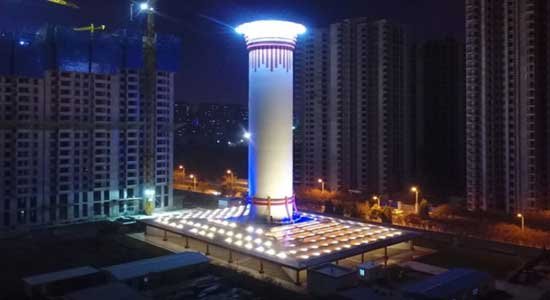Xi’an, one of China’s ancient cities, is known for its rich cultural history and landmarks such as the Terracotta Army.
However, in recent years, the city has faced a severe environmental challenge—air pollution. This problem, exacerbated by rapid industrial growth and geographical factors, has prompted innovative solutions like the air purifier in Xi’an, China.
The air purifier in Xi’an, also called the “smog tower,” is a large-scale experimental project aimed at reducing pollution levels in one of China’s most polluted regions.
This tower has become a symbol of environmental innovation and represents a significant step toward combating urban air pollution.
Also Check: 20+ Best Home Fragrance Luxury Options to Elevate Your Space!
The Problem: Air Pollution in Xi’an, China
What Causes Air Pollution in Xi’an?
Xi’an’s air pollution stems from several factors:
- Industrial Activity: Xi’an is a hub for heavy industries, including manufacturing and construction, which emit large quantities of pollutants into the air.
- Vehicular Emissions: With a growing population and an increase in car ownership, exhaust emissions significantly contribute to the city’s air pollution.
- Geographical Factors: Xi’an is located in a basin surrounded by mountains, which trap pollutants, especially during the winter months when temperature inversions are common.
- Coal Dependency: A substantial portion of Xi’an’s energy still comes from coal, which releases harmful particles when burned.

The Impact of Air Pollution in Xi’an
The effects of air pollution in Xi’an are far-reaching:
- Health Effects: Respiratory diseases such as asthma and bronchitis are common; chronic exposure may create cardiovascular problems. The WHO reports that the high level of particulate matter (PM2.5 and PM10) presents serious health risks.
- Environmental Degradation: Air pollution affects local ecosystems in the form of low crop yields and contamination of water resources.
- Economic Costs: The Chinese government spends billions on healthcare and pollution management, while businesses lose productivity due to pollution-related health issues among workers.
Air Quality Data in Xi’an
Xi’an has often been ranked as one of China’s most polluted cities. According to air quality reports, PM2.5 levels in Xi’an frequently exceed safe limits set by the WHO. For instance:
| Year | Average PM2.5 Level (μg/m³) | WHO Safe Limit (μg/m³) |
|---|---|---|
| 2020 | 57 | 10 |
| 2021 | 53 | 10 |
Such data underscores the urgency of innovative solutions like the air purifier in Xi’an, China.
The Solution: Air Purifier in Xi’an, China
What Is the Air Purifier in Xi’an?
The air purifier in Xi’an, China, also known as the smog tower, is a groundbreaking environmental project designed to address the city’s persistent air quality issues.
This towering structure stands approximately 100 meters (328 feet) tall, making it one of the largest outdoor air purification systems globally. Its purpose is to reduce harmful pollutants like PM2.5 and PM10 particles, which pose significant health risks to residents.
The tower was developed by the Institute of Earth Environment at the Chinese Academy of Sciences. Since its inception, it has been lauded as a pioneering effort to combat urban air pollution through large-scale technological innovation.
How Does the Xi’an Smog Tower Work?
The air purifier in Xi’an operates on a solar-powered filtration system, which is both innovative and eco-friendly. Here’s how it functions:
a.) Solar-Heated Greenhouses
- Around the bottom of the tower are greenhouses that collect and heat polluted air using energy from the sun.
- The heated air rises naturally, reducing reliance on other sources of power.
b.) Air Through the Tower
- Heated air travels through the tower, passing several levels of filtration systems.
- Advanced filters remove particulate matter, carbon dioxide, and other harmful substances.
c.) Clean Air Dispersion
After filtration, it releases clean air into the atmosphere, greatly improving air quality of the surrounding areas.
This system reportedly purifies over 10 million cubic meters of air per day, covering an area of 10 square kilometers. It has been described as a beacon of hope for cities battling severe pollution.
Who Developed the Air Purifier?
The project was led by researchers of the Chinese Academy of Sciences, particularly the Institute of Earth Environment. Its work is part of broader efforts by China to curb pollution under the “Blue Sky” initiative, which looks to drastically cut the levels of air pollution nationwide.
Dr. Cao Junji, a leading researcher on the project, emphasized that the tower’s design integrates solar power and low-energy filtration systems to achieve maximum efficiency with minimal environmental impact. This makes it a cost-effective solution compared to traditional air purifiers.
Achievements and Performance
Since its launch, the air purifier in Xi’an, China, has demonstrated measurable success:
- Reduction of Pollution: During test runs, the tower decreased PM2.5 levels by 19% on areas where the influence is direct.
- Improved Visibility: Locals spoke about a clearer sky and less intense smog on particularly high-pollution days.
- Energy Efficiency: Unlike miniature air purifiers, this system relies much on natural airflow and solar energy, thus minimizing operational costs.
Case Study: January Results
During one particularly bad pollution episode last January, it produced more than 353 million cubic feet of clean air in a single day. Even when other areas reported hazardous levels, this smog tower kept the air quality in a moderate range.
The Broader Context: Outdoor Air Purifiers Globally
Are Large-Scale Air Purifiers Effective?
The success of the air purifier in Xi’an, China, has sparked interest in similar large-scale air purification projects worldwide. However, the effectiveness of such systems remains a topic of discussion.
While they show promise in localized pollution reduction, critics point to challenges in scalability and cost.
Examples of Similar Projects
- Smog-Free Tower in Rotterdam, Netherlands
- Designed by artist and innovator Daan Roosegaarde, this smaller tower uses ionization technology to capture fine dust particles.
- It processes approximately 30,000 cubic meters of air per hour.
- India’s Smog Towers
- Delhi introduced two large smog towers in Connaught Place and Anand Vihar to tackle its notorious air pollution.
- The towers use a combination of fans and high-efficiency particulate air (HEPA) filters.
- Beijing’s Filtration Walls
- Outdoor filtration systems installed in public spaces aim to improve local air quality for pedestrians.
These projects demonstrate the growing interest in combating urban air pollution through technology. However, as in Xi’an, their overall contribution to large-scale pollution control remains limited.
Advantages and Limitations of Large-Scale Air Purifiers
Advantages
- Localized Impact: Significant reduction in pollutants in specific areas.
- Eco-Friendly Design: Many use renewable energy sources like solar power.
- Public Awareness: Such installations highlight the need for urgent action against air pollution.
Limitations
- Scalability Issues: Systems like the Xi’an smog tower are expensive and require large areas for installation.
- Limited Range: They cannot replace widespread measures such as reducing emissions.
- Energy Dependence: While some are solar-powered, others require substantial electricity, increasing carbon footprints.
Data Comparison: Xi’an vs. Other Projects
| Project Location | Height | Air Processed Daily | Cost (Estimated) |
|---|---|---|---|
| Xi’an, China | 100 meters | 10 million m³ | $2 million (trial phase) |
| Delhi, India | 24 meters | 1.2 million m³ | $1.9 million per tower |
| Rotterdam, Netherlands | 7 meters | 30,000 m³/hour | $54,000 |
Criticisms and Challenges
Experts have highlighted key concerns regarding large-scale purifiers:
- Temporary Relief: These systems address symptoms, not root causes. Reducing emissions at their source remains crucial.
- Cost vs. Benefit: The expense of building and maintaining these towers might outweigh their localized benefits.
- Dependence on Weather: Projects like the air purifier in Xi’an rely on solar energy, limiting their efficiency during cloudy or winter days.
Dr. Denise Mauzerall from Princeton University stated in a BBC interview that “while innovative, these technologies should complement stricter pollution control policies rather than serve as a standalone solution.”
Broader Solutions to Air Pollution in Xi’an
Government Policies and Initiatives
While innovations like the air purifier in Xi’an, China, are promising, long-term air quality improvements require systemic changes. The government has introduced various policies to tackle pollution at its source:
- Transition to Renewable Energy
Xi’an is shifting away from coal-powered energy plants to cleaner energy sources such as wind, solar, and hydroelectric power.
According to the International Energy Agency, China has raised its renewable energy capacity by more than 25% over recent years.
2. Emission Control Regulations
Tighter vehicle-emission standards, including a ban on older diesel vehicles.
Encouragement of electric cars by means of subsidies and increased charging facilities.
3. Industrial Emission Reductions
Industries are being compelled to resort to cleaner means of production.
The government provides financial incentives for factories that achieve targets for emissions.
4. Tree-planting Programs
Large-scale tree-planting efforts to create “green belts” around the city naturally absorb pollutants and purify the air.
Individual and Community Efforts
It is very important to involve the public in reducing air pollution. Here are some very simple ways one could reduce air pollution, and would make a big difference:
- Public Transport: Promote buses, trains, and bicycles to minimize vehicle emissions.
- Energy Conservation: Households can do their part by minimizing the use of electricity, using energy-saving appliances.
- Advocacy and Awareness: Local communities are organizing awareness campaigns to educate citizens on air pollution and its health impacts.
Frequently Asked Questions about the Air Purifier in Xi’an, China
What Makes the Air Purifier in Xi’an Unique?
The smog tower’s combination of solar-heated greenhouses and advanced filtration systems allows it to purify large volumes of air efficiently. Its design minimizes energy consumption while maximizing coverage, setting it apart from smaller, traditional purifiers.
How Much Air Does the Xi’an Tower Purify Daily?
The purifier processes approximately 10 million cubic meters of air daily, significantly improving air quality in a 10-square-kilometer radius.
What Are the Long-Term Plans for the Xi’an Air Purifier?
Researchers aim to replicate this technology in other polluted cities across China. Improvements to scalability and energy efficiency are ongoing, with plans to integrate these towers into urban planning.
Can Tourists Visit the Air Purifier?
While not designed as a tourist attraction, the tower is visible to the public. Visitors may view the surrounding greenhouses and observe its impact on local air quality.
Is the Technology Scalable to Other Cities?
Scalability is promising, but largely based on funding, urban design constraints, and sources of pollution. Researchers are currently examining smaller, less expensive models for possible wider diffusion in the future.
Conclusion: The Role of Innovation in Combatting Pollution
The air purifier in Xi’an, China, represents a bold step toward addressing urban air pollution. Its success demonstrates that innovative technologies can complement policy-driven approaches to improve air quality.
However, long-term solutions must focus on reducing emissions at their source, transitioning to cleaner energy, and involving communities in sustainability efforts.
Xi’an’s smog tower is not just a technological marvel—it is a call to action for governments, industries, and individuals worldwide to prioritize cleaner, healthier air for all.





